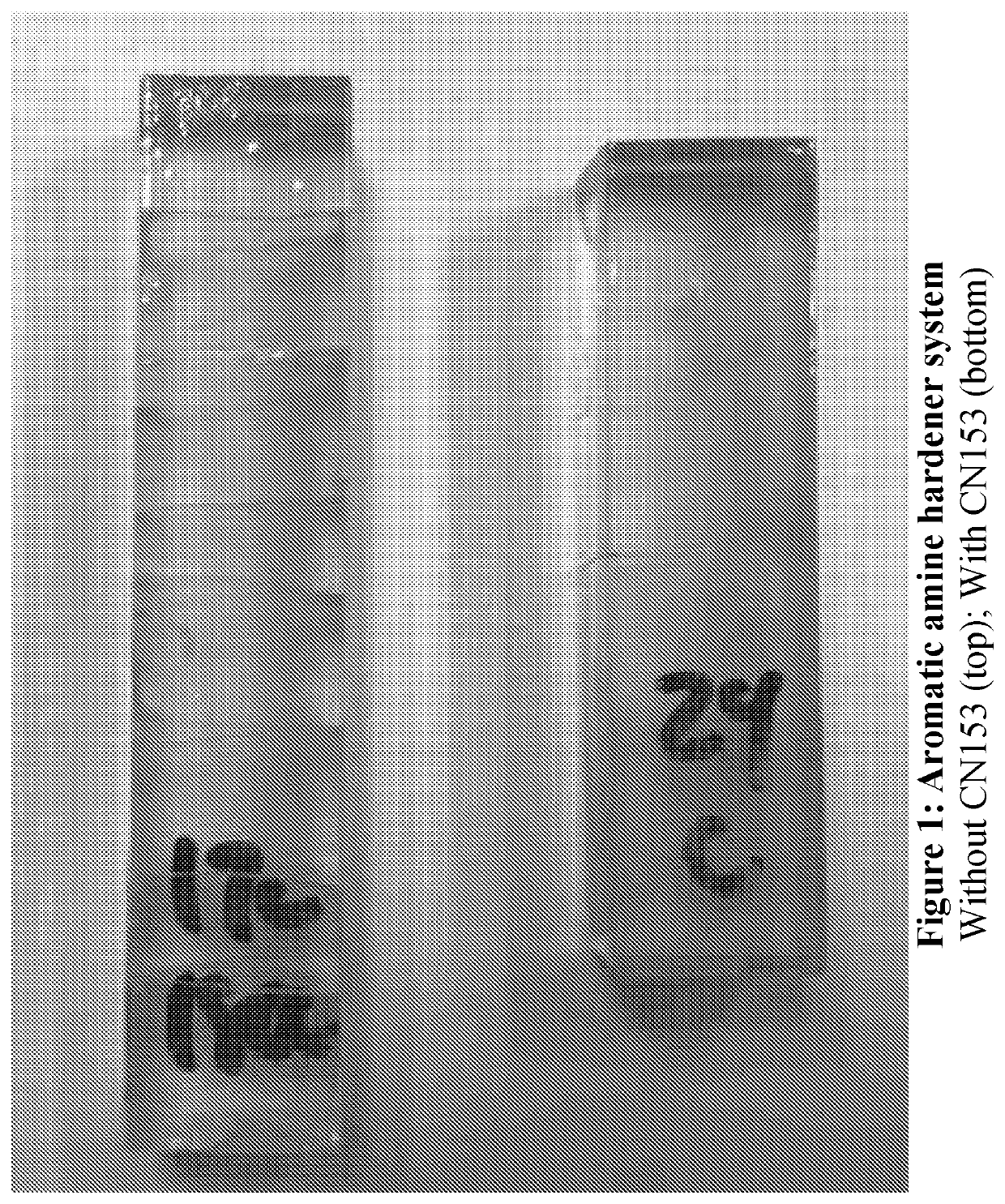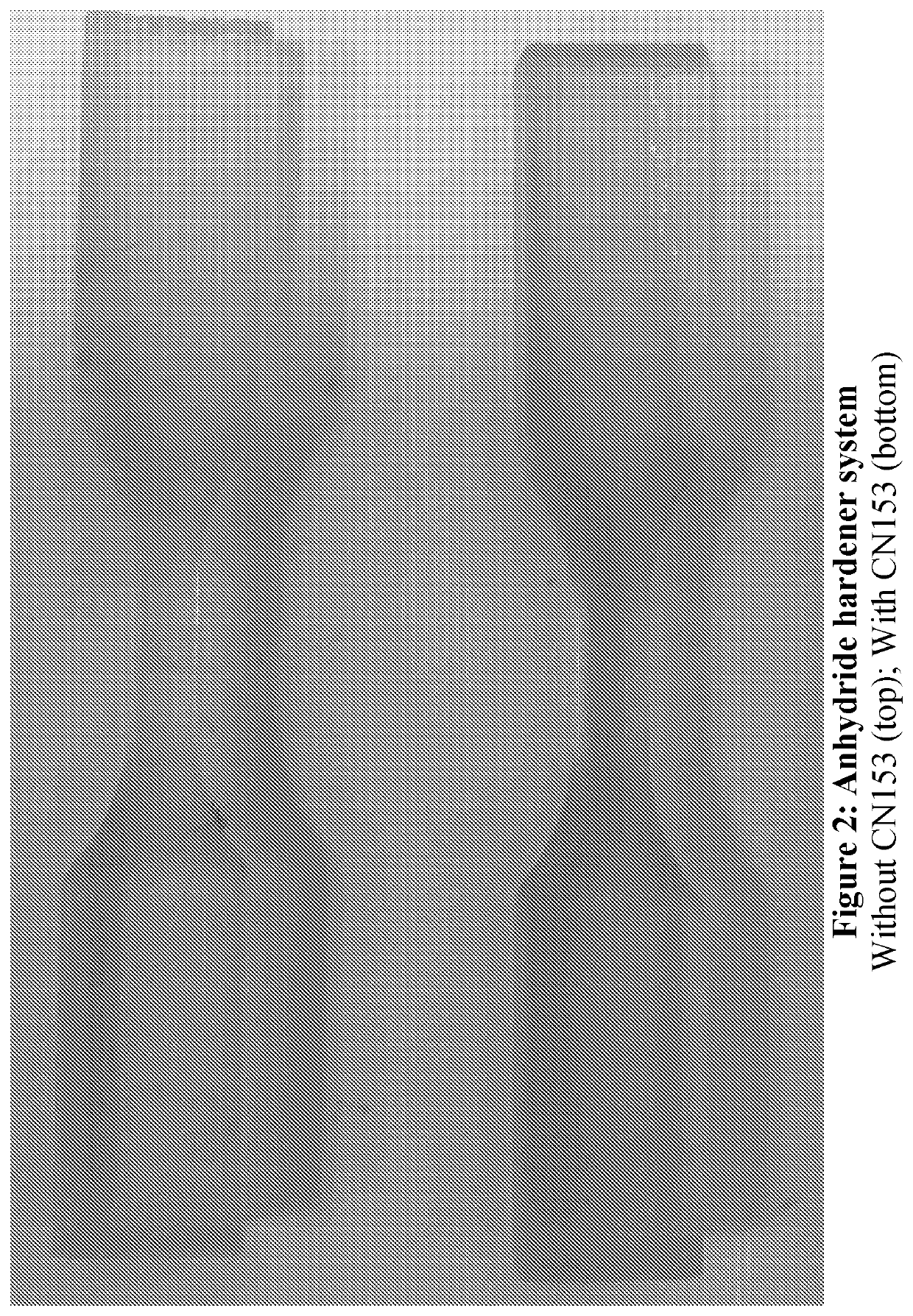Epoxy dual cure resins for additive manufacturing
a technology of epoxy resin and additive manufacturing, applied in the direction of additive manufacturing, manufacturing tools, additive manufacturing apparatus, etc., can solve the problems of general limited material availability of such apparatus, and achieve the effects of high glass transition temperature, high scratch resistance, and high tensile strength
- Summary
- Abstract
- Description
- Claims
- Application Information
AI Technical Summary
Benefits of technology
Problems solved by technology
Method used
Image
Examples
example 1
Aromatic Amine Hardener Resin and Product
[0131]In this example, the hardener is 4,4′-Methylenebis(2,6-diethylaniline) (MDEA), an aromatic amine, which has the structure:
[0132]
A resin composition containing the foregoing hardener was produced having the composition given in Table 1 below:
[0133]
TABLE 1Aromatic amine hardener resin.ComponentNameApprox % by weightEpoxyHuntsman Araldite GY 601030HardenerMDEA20Urethane AcrylateSartomer CN98325DiluentSartomer SR 231 (diethylene18glycol dimethacrylate)Acrylated BPA epoxySartomer CN153 6PhotoinitiatorIrgacure ™ 369 1
[0134]Sartomer products are available from Sartomer Americas, 502 Thomas Jones Way, Exton, Pa. 19341 USA. Irgacure™ 369 is a product of Ciba Specialty Chemicals. Huntsman products are available from Huntsman Advanced Materials Americas, 10003 Woodloch Forest Drive, The Woodlands, Tex. 77380 USA.
[0135]A three-dimensional intermediate object was produced from the resin of Table 1 by Continuous Liquid Interface Production (CLIP). In...
example 2
Polyether Amine Hardener Resin and Product
[0137]In this example the hardener is a polyether amine, specifically Jeffamine D230™ (available from Huntsman Petrochemical Co.), the structure of which is given above. A resin system containing this hardener was produced with the composition given in Table 2 below.
[0138]
TABLE 2Polyether amine hardener resin.ComponentName% by weightEpoxyHuntsman Araldite GY 601012.5HardenerJeffamine D2307Urethane AcrylateSartomer CN98340DiluentSartomer SR 23130Acrylated BPA epoxySartomer CN15310PhotoinitiatorTPO0.5
Three-dimensional intermediate objects were produced from the resin system of Table 2 by CLIP, with the shape of the object being “locked in” by UV light as described in Example 1. The epoxy and Jeffamine D230 react in a second heating cure step by the same mechanism in Example 1. An example cure schedule for this system is 80° C. for 2 hours followed by 125° C. for 3 hours.
example 3
Anhydride Hardener Resin and Product
[0139]In this example, the hardener is an anhydride with an accelerator present to speed the cure. Structures of the anhydride (methyl tetrahydrophthalic anhydride, MTHPA) and the accelerator (benzyldimethylamine, BDMA) are shown below.
[0140]
A resin system containing this hardener and accelerator was produced having the composition given in Table 3 below.
[0141]Three dimensional intermediate objects were produced from the resin of Table 3 by CLIP, essentially as described in Examples 1-2 above. In this example, the epoxy and anhydride are believed to react at high temperature in a mechanism detailed by DOW chemical as shown in Scheme 2 below.
[0142]
TABLE 3Anhydride hardener resin.ComponentNameApprox. % by weightEpoxyHuntsman Araldite GY 601010HardenerMTHPA9AcceleratorBDMA0.5Urethane AcrylateSartomer CN98340DiluentSartomer SR 23130Acrylated BPA epoxySartomer CN15310PhotoinitiatorTPO0.5
[0143]A. Opening of the anhydride ring with a hydroxyl to form the...
PUM
| Property | Measurement | Unit |
|---|---|---|
| temperature | aaaaa | aaaaa |
| viscosity | aaaaa | aaaaa |
| viscosity | aaaaa | aaaaa |
Abstract
Description
Claims
Application Information
 Login to View More
Login to View More - R&D
- Intellectual Property
- Life Sciences
- Materials
- Tech Scout
- Unparalleled Data Quality
- Higher Quality Content
- 60% Fewer Hallucinations
Browse by: Latest US Patents, China's latest patents, Technical Efficacy Thesaurus, Application Domain, Technology Topic, Popular Technical Reports.
© 2025 PatSnap. All rights reserved.Legal|Privacy policy|Modern Slavery Act Transparency Statement|Sitemap|About US| Contact US: help@patsnap.com



